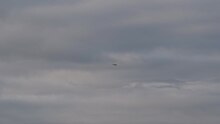Shaking flight

The shaking flight (also known as shaking ) is a special flight technique that some bird species , bat species and some insects use to search for prey or to acquire food. During jolting flight, sometimes also referred to as stationary hover flight, the position of the bird in relation to the ground remains unchanged. The body is kept upright, the wings are at such a large angle of attack that the flapping of the wing does not generate propulsion, but instead generates high lift. The flapping of the wings is fast, the tail is usually wide and bent slightly towards the body. Buoyancy and gravity are in equilibrium, so the animal does not lose height in shaking flight.
Animal species in which the vibration flight can be observed
Not very many bird species have mastered this flying technique. They include many birds of prey and falcons , for example the common buzzard , the common buzzard and the kestrel - sometimes called the "jarring falcon " -, kingfishers , terns , gulls , warblers and flycatchers . Some bat species, such as the brown long-eared bat, also use the shaking flight to acquire food. Modified forms of shaking are used by many birds when landing or when flying up steeply.
The hovering flight observed in the hummingbirds differs fundamentally from the shaking flight of the other bird species. With their wings, hummingbirds describe a lying figure of eight, the leading edge of the wing always pointing in the direction of flapping and thus dynamic lift can be generated when the wings are down and up . Insects such as dragonflies and hover flies are also capable of stationary hovering .
Another species for low-level, slow prey flight has developed the birds of prey of the genus Weihen , the so-called Gaukelflug , and in a similar way many butterflies.
Energy expenditure in shaking flight
The vibration flight requires a lot of energy, as the lift of the airstream is lost and has to be replaced by powerful wing beats. Headwind has an energy-saving effect, so it is generally shaken against the wind.
Despite the high level of effort, kestrels hunt five to six times more often with shaking flight than with hunted hides , because the foraging for food is so more successful. They use the shaking flight especially in places where they are very likely to be able to locate mice, for example, based on their urine traces.
literature
- Günter Vogel, Hartmut Angermann: dtv-Atlas Biology. 2nd volume. Deutscher Taschenbuch Verlag, Munich 1984, ISBN 3-423-03222-7
